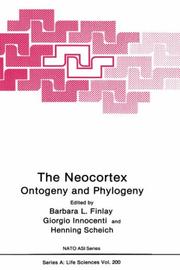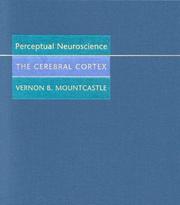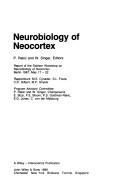| Listing 1 - 10 of 16 | << page >> |
Sort by
|
Article
Abstract | Keywords | Export | Availability | Bookmark
 Loading...
Loading...Choose an application
- Reference Manager
- EndNote
- RefWorks (Direct export to RefWorks)
Brain. --- Neocortex.

ISBN: 0306438089 Year: 1991 Publisher: New York London Plenum
Abstract | Keywords | Export | Availability | Bookmark
 Loading...
Loading...Choose an application
- Reference Manager
- EndNote
- RefWorks (Direct export to RefWorks)
Dissertation
Abstract | Keywords | Export | Availability | Bookmark
 Loading...
Loading...Choose an application
- Reference Manager
- EndNote
- RefWorks (Direct export to RefWorks)
Neocortex --- Neocortex --- Immunology --- Physiology --- Neocortex --- Neocortex --- Immunology --- Physiology

ISBN: 0674661885 9780674661882 Year: 1998 Publisher: Cambridge (Mass.) Harvard university press
Abstract | Keywords | Export | Availability | Bookmark
 Loading...
Loading...Choose an application
- Reference Manager
- EndNote
- RefWorks (Direct export to RefWorks)
Neocortex --- Perception --- physiology --- Supraliminal perception --- Cognition --- Apperception --- Senses and sensation --- Thought and thinking --- Homogenetic cortex --- Isocortex --- Laminated cortex --- Neopallium --- Nonolfactory cortex --- Cerebral cortex --- Neocortex. --- Perception. --- Neocortex - physiology
Article
Year: 1987
Abstract | Keywords | Export | Availability | Bookmark
 Loading...
Loading...Choose an application
- Reference Manager
- EndNote
- RefWorks (Direct export to RefWorks)
Brain. --- Consequences. --- Cortex. --- Lesion. --- Lesions. --- Neocortex. --- Prefrontal cortex. --- Rat. --- Rats.

ISBN: 0471917761 Year: 1988 Volume: vol 42 vol *12 Publisher: Chichester New York Wiley
Abstract | Keywords | Export | Availability | Bookmark
 Loading...
Loading...Choose an application
- Reference Manager
- EndNote
- RefWorks (Direct export to RefWorks)
Neocortex --- -Neurobiology --- -Neurosciences --- Homogenetic cortex --- Isocortex --- Laminated cortex --- Neopallium --- Nonolfactory cortex --- Cerebral cortex --- Congresses --- -Congresses --- Neurobiology --- Neurosciences --- Neocortex - Congresses. --- Neurobiology - Congresses.
Book
ISBN: 9780262356145 0262356147 9780262043243 0262043246 Year: 2019 Publisher: Cambridge : MIT Press,
Abstract | Keywords | Export | Availability | Bookmark
 Loading...
Loading...Choose an application
- Reference Manager
- EndNote
- RefWorks (Direct export to RefWorks)
Experts review the latest research on the neocortex and consider potential directions for future research.Over the past decade, technological advances have dramatically increased information on the structural and functional organization of the brain, especially the cerebral cortex. This explosion of data has radically expanded our ability to characterize neural circuits and intervene at increasingly higher resolutions, but it is unclear how this has informed our understanding of underlying mechanisms and processes.In search of a conceptual framework to guide future research, leading researchers address in this volume the evolution and ontogenetic development of cortical structures, the cortical connectome, and functional properties of neuronal circuits and populations. They explore what constitutes uniquely human mental capacities and whether neural solutions and computations can be shared across species or repurposed for potentially uniquely human capacities.Contributors Danielle S. Bassett, Randy M. Bruno, Elizabeth A. Buffalo, Michael E. Coulter, Hermann Cuntz, Stanislas Dehaene, James J. DiCarlo, Pascal Fries, Karl J. Friston, Asif A. Ghazanfar, Anne-Lise Giraud, Joshua I. Gold, Scott T. Grafton, Jennifer M. Groh, Elizabeth A. Grove, Saskia Haegens, Kenneth D. Harris, Kristen M. Harris, Nicholas G. Hatsopoulos, Tarik F. Haydar, Takao K. Hensch, Wieland B. Huttner, Matthias Kaschube, Gilles Laurent, David A. Leopold, Johannes Leugering, Belen Lorente-Galdos, Jason N. MacLean, David A. McCormick, Lucia Melloni, Anish Mitra, Zoltn Molnr, Sydney K. Muchnik, Pascal Nieters, Marcel Oberlaender, Bijan Pesaran, Christopher I. Petkov, Gordon Pipa, David Poeppel, Marcus E. Raichle, Pasko Rakic, John H. Reynolds, Ryan V. Raut, John L. Rubenstein, Andrew B. Schwartz, Terrence J. Sejnowski, Nenad Sestan, Debra L. Silver, Wolf Singer, Peter L. Strick, Michael P. Stryker, Mriganka Sur, Mary Elizabeth Sutherland, Maria Antonietta Tosches, William A. Tyler, Martin Vinck, Christopher A. Walsh, Perry Zurn
Neocortex. --- NEUROSCIENCE/General --- Homogenetic cortex --- Isocortex --- Laminated cortex --- Neopallium --- Nonolfactory cortex --- Cerebral cortex
Book
Year: 2016 Publisher: Frontiers Media SA
Abstract | Keywords | Export | Availability | Bookmark
 Loading...
Loading...Choose an application
- Reference Manager
- EndNote
- RefWorks (Direct export to RefWorks)
Besides the population of pyramidal neurons using glutamate as a neurotransmitter, GABAergic cortical interneurons form a second, quite heterogeneous group of neurons in the mammalian cerebral cortex. It is actually well appreciated that the interneurons play various important roles in cortical neuronal networks both in normal and pathological states. Based on connectivity pattern, developmental, morphological and electrophysiological properties, distinct subgroups of GABAergic interneurons can be differentiated in the neocortex as well as in the hippocampal formation. In this Research Topic, we concentrate on the inhibitory interneurons expressing calcium-binding protein calretinin (CR). In our opinion, there are many reasons why these cells deserve our special attention. CR expressing (CR+) interneurons differ from other interneuronal populations in their site of origin, in their significantly higher counts in cerebral cortex of primates in comparison to rodents, as well as in their connectivity pattern with high proportion of synapses formed with other interneuronal subtypes. Interestingly, they innervate dendritic inhibitory cells and therefore may play a role in the regulation of the dendritic inputs of pyramidal cells both in the neocortex and hippocampus. CR+ interneurons in the prefrontal cortex were suggested to be instrumental for formation of species-specific neocortical circuits important for cognitive functions of primates. A “gating cell” function of CR+ interneurons – switching the flow of information between two pathways – was suggested in the visual and in the perirhinal cortex. A subpopulation of CR+ interneurons is very probably involved in regulation of blood flow dynamics and energy metabolism in the cortex. Diverse populations of cortical inhibitory interneurons are differently affected in various neurologic and psychiatric disorders. Interestingly, in comparison with other interneuronal types, CR+ interneurons seem to be less compromised in schizophrenia, major depression, Alzheimer disease and multiple sclerosis. The situation was found to be more complex in various epileptic conditions. In this Research Topic we wish to discuss and summarize what is known about calretinin expressing interneurons in mammalian cerebral cortex. Papers dealing with functions of CR+ interneurons in both normal and pathological states are especially welcomed. Differences between CR+ populations in rodent and in primate cortex should also be discussed. All article types (original research, reviews, methodological considerations, opinions) are welcomed. The aim of the research topic is to consolidate the knowledge about this, in our eyes, special interneuronal population and to inspire further research on the function of these neurons, which – functionally – seem to stand at the top of the pyramid of cortical interneuronal types.
Neuroanatomy. --- Interneurons --- Calcium-Binding Proteins --- Epilepsy --- GABA --- claustrum --- Cortical development --- calretinin --- Neocortex --- Cortical Circuits --- Hippocampus
Book
Year: 2016 Publisher: Frontiers Media SA
Abstract | Keywords | Export | Availability | Bookmark
 Loading...
Loading...Choose an application
- Reference Manager
- EndNote
- RefWorks (Direct export to RefWorks)
Besides the population of pyramidal neurons using glutamate as a neurotransmitter, GABAergic cortical interneurons form a second, quite heterogeneous group of neurons in the mammalian cerebral cortex. It is actually well appreciated that the interneurons play various important roles in cortical neuronal networks both in normal and pathological states. Based on connectivity pattern, developmental, morphological and electrophysiological properties, distinct subgroups of GABAergic interneurons can be differentiated in the neocortex as well as in the hippocampal formation. In this Research Topic, we concentrate on the inhibitory interneurons expressing calcium-binding protein calretinin (CR). In our opinion, there are many reasons why these cells deserve our special attention. CR expressing (CR+) interneurons differ from other interneuronal populations in their site of origin, in their significantly higher counts in cerebral cortex of primates in comparison to rodents, as well as in their connectivity pattern with high proportion of synapses formed with other interneuronal subtypes. Interestingly, they innervate dendritic inhibitory cells and therefore may play a role in the regulation of the dendritic inputs of pyramidal cells both in the neocortex and hippocampus. CR+ interneurons in the prefrontal cortex were suggested to be instrumental for formation of species-specific neocortical circuits important for cognitive functions of primates. A “gating cell” function of CR+ interneurons – switching the flow of information between two pathways – was suggested in the visual and in the perirhinal cortex. A subpopulation of CR+ interneurons is very probably involved in regulation of blood flow dynamics and energy metabolism in the cortex. Diverse populations of cortical inhibitory interneurons are differently affected in various neurologic and psychiatric disorders. Interestingly, in comparison with other interneuronal types, CR+ interneurons seem to be less compromised in schizophrenia, major depression, Alzheimer disease and multiple sclerosis. The situation was found to be more complex in various epileptic conditions. In this Research Topic we wish to discuss and summarize what is known about calretinin expressing interneurons in mammalian cerebral cortex. Papers dealing with functions of CR+ interneurons in both normal and pathological states are especially welcomed. Differences between CR+ populations in rodent and in primate cortex should also be discussed. All article types (original research, reviews, methodological considerations, opinions) are welcomed. The aim of the research topic is to consolidate the knowledge about this, in our eyes, special interneuronal population and to inspire further research on the function of these neurons, which – functionally – seem to stand at the top of the pyramid of cortical interneuronal types.
Neuroanatomy. --- Interneurons --- Calcium-Binding Proteins --- Epilepsy --- GABA --- claustrum --- Cortical development --- calretinin --- Neocortex --- Cortical Circuits --- Hippocampus
Book
Year: 2016 Publisher: Frontiers Media SA
Abstract | Keywords | Export | Availability | Bookmark
 Loading...
Loading...Choose an application
- Reference Manager
- EndNote
- RefWorks (Direct export to RefWorks)
Besides the population of pyramidal neurons using glutamate as a neurotransmitter, GABAergic cortical interneurons form a second, quite heterogeneous group of neurons in the mammalian cerebral cortex. It is actually well appreciated that the interneurons play various important roles in cortical neuronal networks both in normal and pathological states. Based on connectivity pattern, developmental, morphological and electrophysiological properties, distinct subgroups of GABAergic interneurons can be differentiated in the neocortex as well as in the hippocampal formation. In this Research Topic, we concentrate on the inhibitory interneurons expressing calcium-binding protein calretinin (CR). In our opinion, there are many reasons why these cells deserve our special attention. CR expressing (CR+) interneurons differ from other interneuronal populations in their site of origin, in their significantly higher counts in cerebral cortex of primates in comparison to rodents, as well as in their connectivity pattern with high proportion of synapses formed with other interneuronal subtypes. Interestingly, they innervate dendritic inhibitory cells and therefore may play a role in the regulation of the dendritic inputs of pyramidal cells both in the neocortex and hippocampus. CR+ interneurons in the prefrontal cortex were suggested to be instrumental for formation of species-specific neocortical circuits important for cognitive functions of primates. A “gating cell” function of CR+ interneurons – switching the flow of information between two pathways – was suggested in the visual and in the perirhinal cortex. A subpopulation of CR+ interneurons is very probably involved in regulation of blood flow dynamics and energy metabolism in the cortex. Diverse populations of cortical inhibitory interneurons are differently affected in various neurologic and psychiatric disorders. Interestingly, in comparison with other interneuronal types, CR+ interneurons seem to be less compromised in schizophrenia, major depression, Alzheimer disease and multiple sclerosis. The situation was found to be more complex in various epileptic conditions. In this Research Topic we wish to discuss and summarize what is known about calretinin expressing interneurons in mammalian cerebral cortex. Papers dealing with functions of CR+ interneurons in both normal and pathological states are especially welcomed. Differences between CR+ populations in rodent and in primate cortex should also be discussed. All article types (original research, reviews, methodological considerations, opinions) are welcomed. The aim of the research topic is to consolidate the knowledge about this, in our eyes, special interneuronal population and to inspire further research on the function of these neurons, which – functionally – seem to stand at the top of the pyramid of cortical interneuronal types.
Neuroanatomy. --- Interneurons --- Calcium-Binding Proteins --- Epilepsy --- GABA --- claustrum --- Cortical development --- calretinin --- Neocortex --- Cortical Circuits --- Hippocampus --- Interneurons --- Calcium-Binding Proteins --- Epilepsy --- GABA --- claustrum --- Cortical development --- calretinin --- Neocortex --- Cortical Circuits --- Hippocampus
| Listing 1 - 10 of 16 | << page >> |
Sort by
|

 Search
Search Feedback
Feedback About
About Help
Help News
News